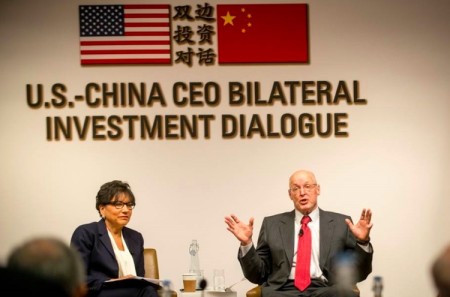By Deborah Lehr

China’s trade negotiators were recently in Washington to continue negotiations towards a bilateral investment treaty between China and the United States. Much still remains to be hammered out: China plans to submit its “negative list”—sectors that will not be opened to foreign competition—after the Chinese New Year, and then tough negotiations will ensue. But the momentum for concluding a treaty is growing—and that is a good thing.
A bilateral investment treaty (BIT) with China would benefit the economies of both the United States and China, by creating new streams of two-way trade and investment. The growing and interdependent economic relationship between the United States and China is the underlying fabric that binds our countries together. It provides a foundation that allows us to disagree on specific issues without threatening the overall relationship. As China becomes a more active player on the world stage, it’s important for the United States to work with China and to support their entry and full participation in global, rules-based institutions.
To delve into the importance of a bilateral investment treaty to both countries, the Paulson Institute—with its partners, Goldman Sachs, the US-China Business Council and the China Development Reform Foundation—convened a US-China CEO Investment Dialogue to explore the implications of a possible agreement to both countries. The discussions included the US Secretary of Commerce, the US Trade Representative, former Secretary of State Henry Kissinger, the Chinese Ambassador, as well as leading US and Chinese CEOs, Mayors and high level opinion leaders. A lively discussion ensued about potential opportunities for increasing jobs, investment and exports. All agreed that it was important that China continue to be part of the rules based systems on trade.
As a former US trade negotiator with China during the WTO and other negotiations, I witnessed first hand how bringing China into the rules based trading systems pays off. In the early 1990s, one of the most transformational commitments we obtained came down to one important line. It simply required China to publish its own trade laws. Previously, China’s trade laws and regulations had been confidential; while companies were expected to abide by them, they could be arrested if they actually read or owned a copy. This requirement of transparency fundamentally changed the trading regime to the benefit of both Chinese and US companies. Two decades later, laws are published and commented on, making the playing field more balanced.
China’s WTO accession provided a ten-year road map for opening and reform of China’s economy. It outlined how sectors would open to foreign competition. And both countries benefited from this transparency. Low cost Chinese exports to the United States have increased over 330 percent since the signing of the agreement. And US exports to China rose by 533 percent since China’s accession.
Yet that ten-year road map ran out four years ago. A high standard bilateral investment treaty can fill the resulting gap. It would bring greater transparency and consistency to the investment environment for both countries.
A bilateral investment treaty would be good for China because the required opening of the market would bring in investments, encouraging more competition in the consumer and services sectors. That in turn would help China achieve its ambitious plan to transform its economic model away from export led growth to a more consumption based model. Such a treaty would also help clarify regulations for Chinese companies investing in the United States.
And why would a bilateral investment treaty be good for the United States? For one, it would create a more transparent and level playing field for US companies in China, leading to greater opportunities for US investors. It would also encourage more Chinese companies to invest in the United States as part of the Chinese government’s “going out” initiative to encourage overseas investment. This in turn, would create jobs and opportunities for American workers.
There is enormous opportunity to increase trade and investments between the United States and China. So far, Chinese actual investment in the United States, less than $4 billion in 2014, is less than 5 percent of the $101 billion that China invested overseas last year. Clear, transparent regulations about investment in the United States might open the doors to more money coming in, creating new jobs. US investment in China, more than $50 billion, no doubt would increase as the playing field becomes more level.
President Xi has set out an ambitious economic reform agenda; just as Premier Zhu Rongji had done at the time of China’s WTO accession. China’s large-scale state owned enterprises and cheap exports are no longer reaping the economic gains they once did. The United States has a unique opportunity to work with China on a new roadmap for future growth.
More engagement with China can lead to positive outcomes for both countries. Indeed, we think it’s crucial.




